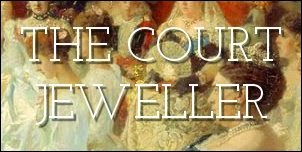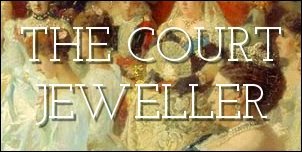
Vintage Royals: Alice and Philip

Sparkling Royal Jewels From Around the World

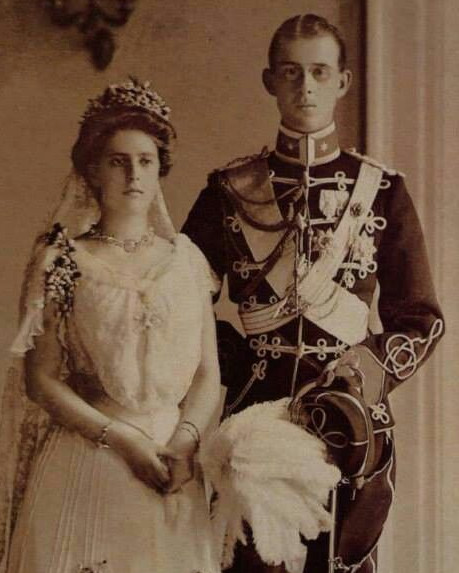 |
| Alice and Andrew on their religious wedding day in Darmstadt [source] |
Darmstadt, Oct. 7 — In the presence of a notable gathering, which included an Emperor, an Empress, a King, and two Queens, the marriage of Princess Alice of Battenberg [1] and Prince Andreas of Greece [2] was celebrated today according to the rites of the Lutheran and Greek churches.
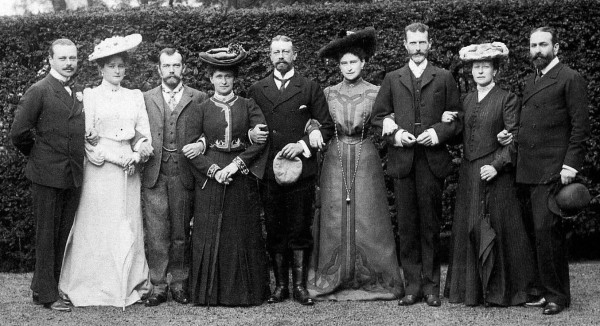 |
| The bride’s aunts, uncles, and parents at the wedding: Grand Duke Ernst of Hesse and by Rhine, Tsarina Alexandra Feodorovna of Russia, Tsar Nicholas II of Russia, Princess Irene of Prussia, Prince Henry of Prussia, Grand Duchess Elisabeth Feodorovna of Russia, Grand Duke Sergei Alexandrovich of Russia, Princess Louis of Battenberg, and Prince Louis of Battenberg [source] |
The wedding party, whose dresses and uniforms made a very effective spectacle, assembled at 3:30 in the old castle, and then crossed the castle yard to the castle church. Prince George of Greece [3] with Princess Victoria [4] led the procession, and they were followed by the Grand Duke of Hesse [5], with the Czarina [6]; the Czar [7], with Queen Alexandra [8]; the members of the Greek royal family, and finally Prince Louis of Battenberg [9], with his daughters, the Princesses Alice [10] and Louise [11].
The church was filled with diplomats, the local authorities, and the royal suites. The Protestant ceremony lasted three-quarters of an hour, the officiating clergyman being the Rev. Dr. Petersen. The party then, amid the ringing of the famous chimes, drove in reverse order to the Greek chapel, a mile distant on the Mathildanhohe, where they were greeted by a large crowd. There the marriage ceremony was celebrated according to the Greek rites by Archpriest Janitcheff, a Russian choir performing the musical service. All then returned directly to the palace.
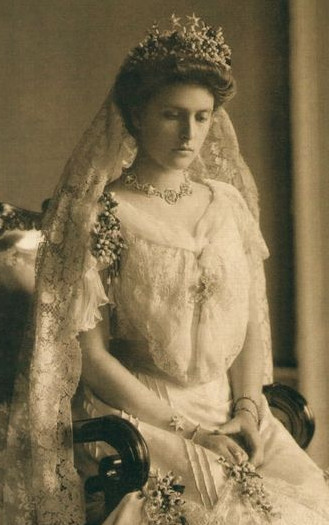 |
| Princess Alice on her wedding day; she wears her mother’s diamond star tiara (later lost in Russia during the revolution) and a diamond circle-and-star necklace that’s said to have been a wedding gift from her mother [source] |
The bride wore white crepe de chine, with orange blossoms, and a bodice of Point de Venise lace. Queen Alexandra was dressed in purple tulle, with sequins, and had a diamond diadem. The Czarina wore a gown of white tulle embroidered with silver, and wore a Russian diadem. The Queen of Greece was in gray satin.
A family dinner was held this evening, with forty-two covers. Afterward the wedded couple started in a motor car, presented by the Czar, for Heiligenberg Castle on a short honeymoon.
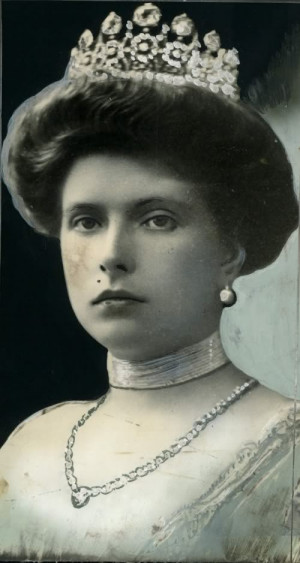 |
| Alice wearing the diamond tiara that may have been her wedding gift from her uncle and aunt, Tsar Nicholas II and Tsarina Alexandra Feodorovna of Russia (see note #12 below) [source] |
The gifts to the bridal couple include a massive silver epergne from the King and Queen of England and a magnificent diadem of brilliants from the Czar and Czarina [12].
The civil marriage of Prince Andrew and Princess Alice took place on Tuesday.
NOTES
1. Princess Andrew of Greece and Denmark (1885-1969), born Princess Alice of Battenberg, was the elder daughter of Prince Louis of Battenberg and Princess Victoria of Hesse and by Rhine. Through her mother, she was a great-granddaughter of Queen Victoria and Prince Albert. She had five children, including the Duke of Edinburgh; she lived a remarkable, complicated life.
2. Prince Andrew of Greece and Denmark (1882-1944) was the seventh child of King George I and Queen Olga of Greece. He met and fell in love with Alice at the coronation of King Edward VII and Queen Alexandra of the United Kingdom in 1902. Queen Alexandra was Andrew’s aunt; King Edward was Alice’s great-uncle.
3. Prince George of Greece and Denmark (1869-1957) was the groom’s elder brother. He was married to Princess Marie Bonaparte but also had a long-lasting, very complex relationship with his uncle, Prince Valdemar of Denmark.
4. Princess Louis of Battenberg (1863-1950), born Princess Victoria of Hesse and by Rhine, the eldest daughter of Grand Duke Louis IV of Hesse and Princess Alice of the United Kingdom (the second daughter of Queen Victoria and Prince Albert). Following World War I, when her husband was stripped of his German title, Victoria was known as the Marchioness of Milford Haven.
5. Grand Duke Ernst of Hesse and by Rhine (1868-1937) was the bride’s uncle. He was the younger brother of Princess Victoria of Hesse. Ernst had been married to another grandchild of Queen Victoria, Princess Victoria Melita of Edinburgh, but two years before this wedding, they divorced. A little over a year after Alice and Andrew’s wedding, Ernst married again, this time to Princess Eleonore of Solms-Hohensolms-Lich. Their son, Georg Donatus, would eventually marry Andrew and Alice’s daughter, Cecilie.
6. Tsarina Alexandra Feodorovna of Russia (1872-1918), born Princess Alix of Hesse and by Rhine, was the bride’s aunt. She was the youngest living sister of Princess Victoria of Hesse. I’m thinking you all know what happened to her, but just in case: hemophilia, Rasputin, revolution, murder.
7. Tsar Nicholas II of Russia (1868-1918) was the groom’s first cousin; his mother, who was born Princess Dagmar of Denmark, was the sister of King George I of Greece. Again, I’m thinking you all know what happened to him; see above.
8. Queen Alexandra of the United Kingdom (1844-1925), born Princess Alexandra of Denmark, was the groom’s aunt; she was the sister of King George I of Greece. She was also the bride’s great-aunt, as her husband, King Edward VII, was the brother of the bride’s grandmother, Princess Alice of the United Kingdom.
9. Prince Louis of Battenberg (1854-1921) was the bride’s father. He had a German princely title (his father was a Hessian prince), but he served in the British royal navy, even becoming First Sea Lord in 1912. He relinquished his German title in the wake of World War I and adopted the Anglicized surname “Mountbatten”; King George V subsequently made him the Marquess of Milford Haven. His children were all prominent 20th century royal figures: Princess Andrew of Greece, Queen Louise of Sweden, Earl Mountbatten, and George, 2nd Marquess of Milford Haven.
10. This is Princess Alice, the bride.
11. Princess Louise of Battenberg (1889-1965), younger sister of the bride. She became Lady Louise Mountbatten when the family’s German titles were removed in 1917; six years later, she married the widowed Crown Prince Gustaf Adolf of Sweden and eventually became Queen Louise of Sweden.
12. This bit of information raises an interesting question: which of Alice’s tiaras was the Russian gift? There are photographs of Alice wearing four tiaras during her lifetime. The first, her wedding tiara, never belonged to her; it was borrowed from her mother, Princess Victoria, and was lost in Russia during the revolution. The second “tiara” was actually Alice’s wedding necklace set on a frame; I’ve seen it stated that the necklace was Alice’s wedding gift from her mother. That leaves two tiaras that belonged personally to the princess: the meander tiara that now belongs to Princess Anne, and the diamond tiara that was broken up in the late 1940s for Queen Elizabeth II’s engagement ring and wedding bracelet. By the description of the piece as a “magnificent diadem,” I’m guessing it’s the latter, which was quite large, rather than the small bandeau-style meander tiara. The photographs of Alice wearing the larger diamond tiara are also from an earlier period of her life than the photographs showing the meander tiara. Any and all thoughts on this subject are welcome in the comments!
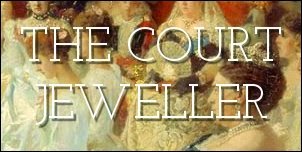
Yesterday on the blog I featured a film clip from Queen Friederike of Greece’s 1964 visit to New York. In the film, she wears the magnificent diamond tiara that belonged to Queen Sophie, along with a necklace featuring a stunning pendant: an enormous 478-carat sapphire that came from the collection of Queen Marie of Romania. How did this gemstone, one of the largest sapphires in the world, get from Romania to Greece? Read on…
The first records of the sapphire’s existence place it in Cartier’s workshop in Paris around 1913. It was originally set in a sautoir necklace with a number of other sapphires; however, the firm changed the design of the piece to showcase the sapphire as a single pendant on a diamond and platinum necklace. That version of the necklace was put on exhibit in 1919 in San Sebastian, Spain. Hans Nadelhoffer’s book on Cartier notes that the necklace was the showstopper piece of the jeweler’s autumn show that year, and viewers included Queen Ena of Spain and her mother-in-law, Queen Maria Cristina. According to Nadelhoffer, Ena even tried the necklace on, possibly hoping that her husband, King Alfonso, would purchase it for her. (No dice, unfortunately: Alfonso said no.)
Instead, a different monarch ended up buying the necklace: King Ferdinand of Romania. He purchased the necklace in 1921 on an installment plan, paying around 1,375,000 francs in total. (And remember, that’s at a 1920s rate.) Ferdinand was married to the glamorous and dramatic Queen Marie, daughter of Prince Alfred, Duke of Saxe-Coburg and Gotha (a son of Queen Victoria and Prince Albert) and his Romanov wife, Grand Duchess Maria Alexandrovna of Russia. Marie had lost many of her jewels in Russia during the war, and she and Ferdinand were on a mission to replenish her jewelry box.
Ferdinand had succeeded to the Romanian throne in 1914, but his reign had been quickly disrupted by World War I. In 1922, the year after he bought the sapphire, he and Marie were finally crowned. For the October coronation, Marie wore the diamond sautoir with the enormous sapphire pendant. Two years later, she paired the necklace with a diamond and sapphire tiara that she had purchased from one of her Romanov relatives, the famous Grand Duchess Vladimir, for a portrait sitting with Philip de Laszlo.
Even after the end of the war, though, Romanian politics were complex. Ferdinand died in 1927, and his son, Carol, began a tumultuous reign marked by scandal, abdication, and eventual exile. By 1947, Carol’s only son, Michael, was on the throne; he was compelled to abdicate by the government. With the family in increasingly dire straits, the sapphire pendant was sold. The buyer was another major name in jewelry: Harry Winston. (The family actually kept the diamond portion of the necklace for a bit longer. It was worn in 1948 by Princess Anne of Bourbon-Parma at her wedding to King Michael, which you can see in the footage above. It’s since been broken up.)
The royal story of the sapphire pendant could have ended there — but it didn’t. Vincent Meylan writes in The Queen’s Jewels that Harry Winston sold the sapphire pendant to a wealthy Greek citizen, who in turn presented it to his nation’s queen consort: Friederike, the wife of King Paul. Friederike suspended the sapphire from a pearl and diamond necklace. You can see a glimpse of the sapphire on Friederike in the photograph above, taken at a banquet at Claridge’s in London in 1963.
Friederike took the sapphire with her during her 1964 trip to New York. She also wore the piece that September during the wedding festivities for her only son, King Constantine II, and Princess Anne-Marie of Denmark.
She also wore the sapphire at the wedding of Prince Michael of Greece in 1965. But then, the whereabouts of the sapphire become a bit murky. The Greek monarchy was abolished for good in the 1970s, and the family went into exile. Queen Friederike ended up in Spain, where her daughter, Sofia, was queen, while the king and his family relocated to England. The sapphire popped again in public in November 2003, when it was put up for auction at Christie’s in Geneva. In the auction notes, the lot was offered for sale by “a noble family.”
There are basically two ways to interpret that sale note. One is that the Greek royals quietly disposed of the sapphire pendant some time after Queen Friederike’s death, and the piece was purchased by a noble family, who then decided to sell the piece in a public auction. But it’s also entirely possible that these “nobles” were indeed the former Greek royals themselves. It’s pretty common for royals to present items for auction under slightly pseudonymous conditions. There’s a fine line to be trodden: items that have established royal provenance and links to current royal owners sell for higher prices at auction, but selling royal jewelry can lead to some backlash, especially when a piece was a gift from a generous countryman. (For an example, see the excellent work of my friends over at Luxarazzi on the announced sale, then the cancellation of the sale, and then ultimately eventual auction of many of the jewels of the late Grand Duchess Josephine-Charlotte of Luxembourg.)
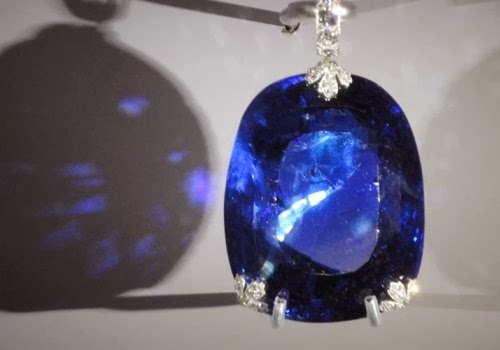 |
| Photo used with the kind permission of thoughtful reader Nancy, who visited the Cartier exhibition. She retains the copyright; do not reproduce. |
Queen Marie and Queen Friederike’s sapphire pendant was the largest sapphire ever offered at auction when it was sold. When the gavel fell, the jewel had fetched more than $1.4 million. It’s owned privately today, but last year, the sapphire went on display as a part of the Cartier: Style and History exhibition in Paris. Nearly a hundred years after it sparkled in Spain at Cartier’s autumn show, the sapphire pendant dazzled public viewers all over again.
